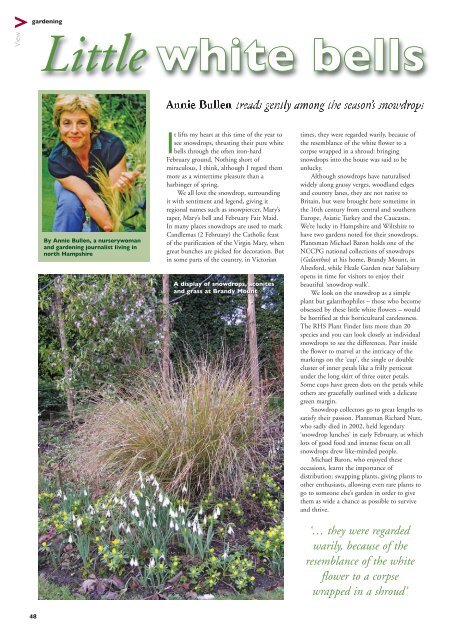01 VIEWFEB:NOVEMBER COVER - View Magazines
01 VIEWFEB:NOVEMBER COVER - View Magazines
01 VIEWFEB:NOVEMBER COVER - View Magazines
Create successful ePaper yourself
Turn your PDF publications into a flip-book with our unique Google optimized e-Paper software.
<strong>View</strong><br />
vgardening<br />
Little white bells<br />
48<br />
By Annie Bullen, a nurserywoman<br />
and gardening journalist living in<br />
north Hampshire<br />
Annie Bullen treads gently among the season’s snowdrops<br />
It lifts my heart at this time of the year to<br />
see snowdrops, thrusting their pure white<br />
bells through the often iron-hard<br />
February ground. Nothing short of<br />
miraculous, I think, although I regard them<br />
more as a wintertime pleasure than a<br />
harbinger of spring.<br />
We all love the snowdrop, surrounding<br />
it with sentiment and legend, giving it<br />
regional names such as snowpiercer, Mary’s<br />
taper, Mary’s bell and February Fair Maid.<br />
In many places snowdrops are used to mark<br />
Candlemas (2 February) the Catholic feast<br />
of the purification of the Virgin Mary, when<br />
great bunches are picked for decoration. But<br />
in some parts of the country, in Victorian<br />
A display of snowdrops, aconites<br />
and grass at Brandy Mount<br />
times, they were regarded warily, because of<br />
the resemblance of the white flower to a<br />
corpse wrapped in a shroud: bringing<br />
snowdrops into the house was said to be<br />
unlucky.<br />
Although snowdrops have naturalised<br />
widely along grassy verges, woodland edges<br />
and country lanes, they are not native to<br />
Britain, but were brought here sometime in<br />
the 16th century from central and southern<br />
Europe, Asiatic Turkey and the Caucasus.<br />
We’re lucky in Hampshire and Wiltshire to<br />
have two gardens noted for their snowdrops.<br />
Plantsman Michael Baron holds one of the<br />
NCCPG national collections of snowdrops<br />
(Galanthus) at his home, Brandy Mount, in<br />
Alresford, while Heale Garden near Salisbury<br />
opens in time for visitors to enjoy their<br />
beautiful ‘snowdrop walk’.<br />
We look on the snowdrop as a simple<br />
plant but galanthophiles – those who become<br />
obsessed by these little white flowers – would<br />
be horrified at this horticultural carelessness.<br />
The RHS Plant Finder lists more than 20<br />
species and you can look closely at individual<br />
snowdrops to see the differences. Peer inside<br />
the flower to marvel at the intricacy of the<br />
markings on the ‘cup’, the single or double<br />
cluster of inner petals like a frilly petticoat<br />
under the long skirt of three outer petals.<br />
Some cups have green dots on the petals while<br />
others are gracefully outlined with a delicate<br />
green margin.<br />
Snowdrop collectors go to great lengths to<br />
satisfy their passion. Plantsman Richard Nutt,<br />
who sadly died in 2002, held legendary<br />
‘snowdrop lunches’ in early February, at which<br />
lots of good food and intense focus on all<br />
snowdrops drew like-minded people.<br />
Michael Baron, who enjoyed these<br />
occasions, learnt the importance of<br />
distribution: swapping plants, giving plants to<br />
other enthusiasts, allowing even rare plants to<br />
go to someone else’s garden in order to give<br />
them as wide a chance as possible to survive<br />
and thrive.<br />
‘… they were regarded<br />
warily, because of the<br />
resemblance of the white<br />
flower to a corpse<br />
wrapped in a shroud’





